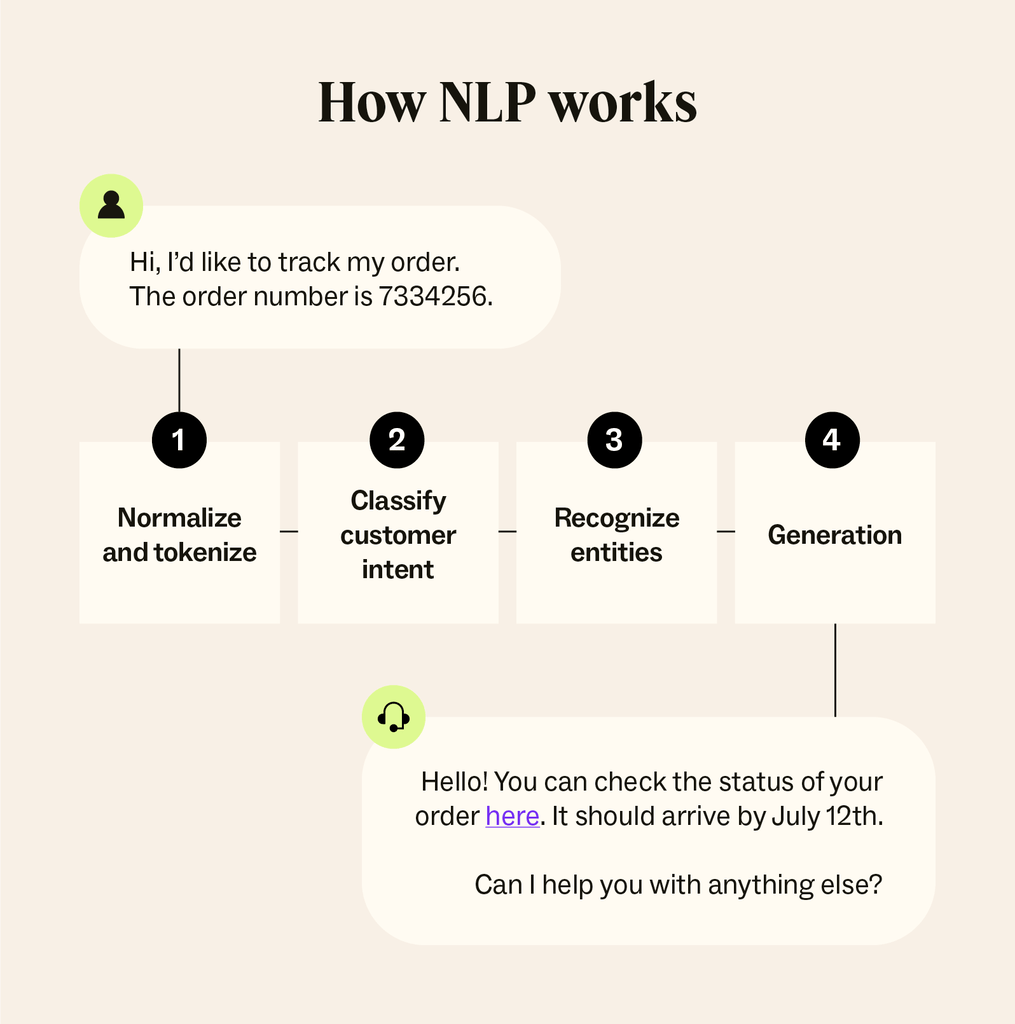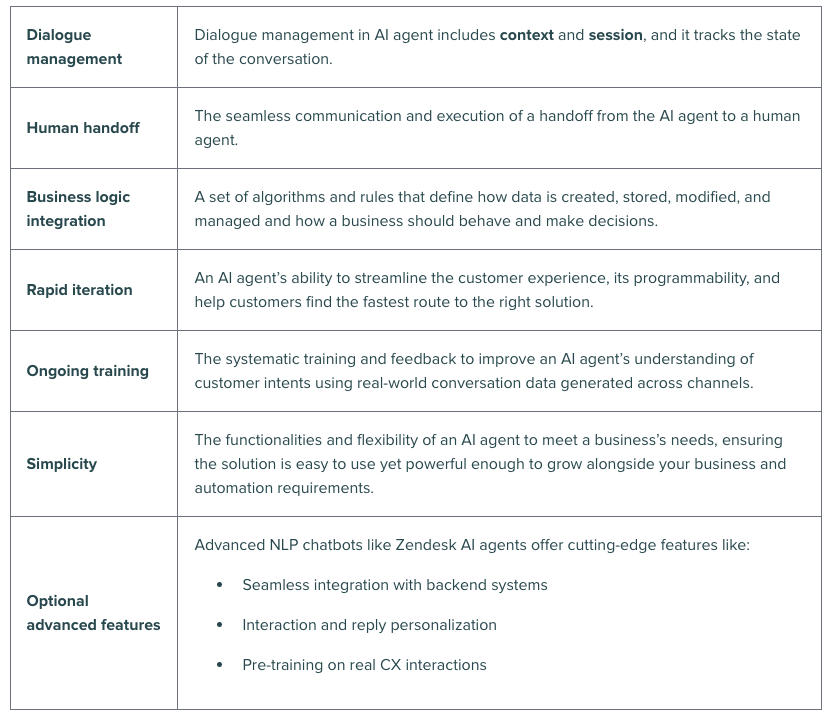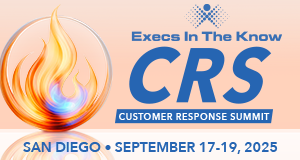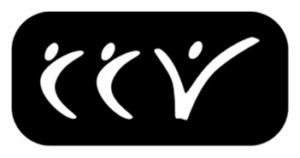Artificial intelligence (AI)—particularly AI in customer service—has come a long way in a short amount of time. The chatbots of the past have evolved into highly intelligent AI agents capable of providing personalized responses to complex customer issues. According to our Zendesk Customer Experience Trends Report 2024, 70 percent of CX leaders believe bots are becoming skilled architects of highly personalized customer journeys.
AI-powered bots like AI agents use natural language processing (NLP) to provide conversational experiences. The astronomical rise of generative AI marks a new era in NLP development, making these AI agents even more human-like. Discover how NLP chatbots work, their benefits and components, and how you can automate 80 percent of customer interactions with AI agents, the next generation of NLP chatbots.
More in this guide:
- What is an NLP chatbot?
- NLP bot vs. rule-based chatbots
- How a natural language processing chatbot works
- Key components of NLP-powered bots
What is an NLP chatbot?
A natural language processing chatbot is a software program that can understand and respond to human speech. NLP-powered bots—also known as NLP agents—allow people to communicate with computers in a natural and human-like way, mimicking person-to-person conversations.
These clever AI agents have a wide range of applications in the customer support sphere, like:
- Making it easier and more affordable for your business to grow.
- Giving your team valuable time back to focus on more meaningful work, ultimately evolving them into a new kind of role, as a manager, editor, and supervisor of AI.
- Seamlessly connecting with your backend systems, instantly recognizing who they’re talking to. From there, they provide personalized support with key details for an exceptional customer experience.
- Providing 24/7 support in multiple languages, which results in better experiences for your customers.
These applications are just some of the abilities of NLP-powered AI agents.
NLP vs. NLU vs. NLG
Don’t know your NLP from your NLG? Don’t fret—we know there are quite a few acronyms in the world of chatbots and conversational AI. Here are three key terms that will help you understand NLP chatbots, AI, and automation.
- Natural language processing (NLP): A branch of artificial intelligence designed to improve human-bot communication by enabling machines to understand, analyze, and respond to human speech or writing.
- Natural language understanding (NLU): A subset of NLP that focuses on machine comprehension, ensuring bots understand the meaning behind linguistic input (whether verbal or written) so they can convert language into a logical form a computer algorithm can understand.
- Natural language generation (NLG): Another subset of NLP that refers to the automatic replies created by a bot and works like NLU in reverse. After generating a logical response, the bot converts the output to a natural language that a human can easily understand.
While NLU and NLG are subsets of NLP, they all differ in their objectives and complexity. However, all three processes enable AI agents to communicate with humans.
NLP bot vs. rule-based chatbots
When you think of a “chatbot,” you may picture the buggy bots of old, known as rule-based chatbots. These bots aren’t very flexible in interacting with customers because they use simple keywords or pattern matching rather than leveraging AI to understand a customer’s entire message.
For example, a rule-based chatbot may know how to answer the question, “What is the price of your membership?” based on similar messages from previous interactions. You can teach these bots how to respond to this question, but the wording must be an exact match, so your bot builder will need to manually program phrasing nuances for every possible question a customer might ask.
Because of this specific need, rule-based bots often misunderstand what a customer has asked, leaving them unable to offer a resolution. Instead, businesses are now investing more often in NLP AI agents, as these intelligent bots rely on intent systems and pre-built dialogue flows to resolve customer issues. A chatbot using NLP will keep track of information throughout the conversation and use machine or deep learning to learn as it goes, becoming more accurate over time.
NLP-powered chatbots use the following keys to interpret interactions:
- Utterances: The ways the user refers to a specific intent
- Intent: The meaning behind the words a user types or says
- Entity: The details important to intent, like order numbers and location
- Context: The parameters across a session
- Session: A conversation from start to finish, even if interrupted
While rule-based chatbots aren’t entirely useless, bots leveraging conversational AI are significantly better at understanding, processing, and responding to human language. For many organizations, rule-based chatbots are not powerful enough to keep up with the volume and variety of customer queries—but NLP AI agents and bots are.
How a natural language processing chatbot works

Bots using a conversational interface—and those powered by large language models (LLMs)—use major steps to understand, analyze, and respond to human language. For NLP chatbots, there’s also an optional step of recognizing entities.
Let’s take a closer look at how a natural language processing chatbot works:
- Normalizing: Bots remove irrelevant details and convert words to a standardized version. For example, bots will lowercase language inputs.
- Tokenizing: Chatbots chop the language input into pieces—or tokens—and remove punctuation.
- Intent classification: With normalized and tokenized text, the bot uses AI to identify the issue or intent the customer is asking about.
- Recognizing entities (optional): This optional step is where chatbots identify anything else referred to in a message, such as an order number, email address, or transaction ID.
- Generation: For next-gen NLP AI agents, the AI model generates a number of responses and selects the most appropriate response to send to the user.
The AI technology behind NLP bots is advanced and powerful. Now that you understand the inner workings of NLP, you can learn about the key elements of this technology.
Key components of NLP-powered bots
NLP bots use AI to process human language. The key components of NLP-powered AI agents enable this technology to analyze interactions and are incredibly important for developing bot personas.
Here are some of the most important elements of an NLP bot:

To learn more about the types of NLP chatbots and their benefits read the full article: What are NLP chatbots and how do they work?

































 Trista Miller
Trista Miller




















































 ibex delivers innovative BPO, smart digital marketing, online acquisition technology, and end-to-end customer engagement solutions to help companies acquire, engage and retain customers. ibex leverages its diverse global team and industry-leading technology, including its AI-powered ibex Wave iX solutions suite, to drive superior CX for top brands across retail, e-commerce, healthcare, fintech, utilities and logistics.
ibex delivers innovative BPO, smart digital marketing, online acquisition technology, and end-to-end customer engagement solutions to help companies acquire, engage and retain customers. ibex leverages its diverse global team and industry-leading technology, including its AI-powered ibex Wave iX solutions suite, to drive superior CX for top brands across retail, e-commerce, healthcare, fintech, utilities and logistics. TELUS Digital
TELUS Digital



